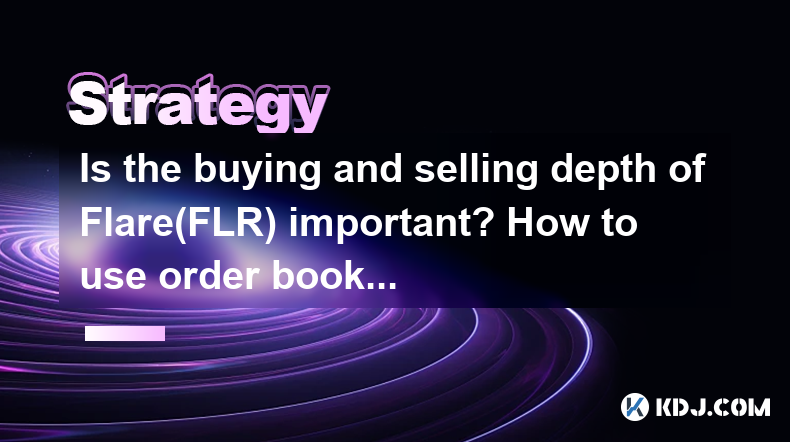-
 bitcoin
bitcoin $122025.899241 USD
-2.12% -
 ethereum
ethereum $4488.068729 USD
-4.11% -
 bnb
bnb $1315.348019 USD
8.65% -
 tether
tether $1.000457 USD
0.03% -
 xrp
xrp $2.875326 USD
-3.69% -
 solana
solana $222.043604 USD
-4.07% -
 usd-coin
usd-coin $0.999682 USD
0.00% -
 dogecoin
dogecoin $0.249887 USD
-5.62% -
 tron
tron $0.337379 USD
-2.59% -
 cardano
cardano $0.827763 USD
-5.06% -
 hyperliquid
hyperliquid $45.774531 USD
-2.43% -
 chainlink
chainlink $22.079309 USD
-5.87% -
 ethena-usde
ethena-usde $1.000156 USD
0.02% -
 sui
sui $3.482566 USD
-3.57% -
 stellar
stellar $0.386982 USD
-4.92%
Is the buying and selling depth of Flare(FLR) important? How to use order book data?
The depth of FLR's order book is crucial for traders, indicating liquidity and potential price stability; a deep book absorbs large trades with minimal price impact.
May 03, 2025 at 08:57 pm

Understanding the Importance of Buying and Selling Depth for Flare (FLR)
The buying and selling depth of a cryptocurrency like Flare (FLR) is a crucial metric for traders and investors alike. Depth refers to the quantity of buy and sell orders at various price levels within the order book of an exchange. This metric provides insights into the liquidity and potential price stability of FLR. A deep order book indicates a high level of liquidity, which means large orders can be executed without significantly affecting the market price. Conversely, a shallow order book suggests lower liquidity, where even small trades can cause substantial price movements.
How Liquidity Affects FLR Trading
Liquidity is a vital aspect of trading Flare (FLR) because it impacts the ease with which traders can enter and exit positions. High liquidity in the FLR market means that there are enough buyers and sellers to facilitate smooth trading. This reduces the risk of slippage, where the price changes between the time an order is placed and when it is executed. On the other hand, low liquidity can lead to increased volatility and larger spreads between the bid and ask prices, making it more challenging and potentially more costly to trade FLR.
Analyzing the Order Book for FLR
The order book is a real-time, continuously updated list of buy and sell orders for FLR on a specific exchange. It is divided into two sections: the bid side, which lists the prices and quantities at which traders are willing to buy FLR, and the ask side, which lists the prices and quantities at which traders are willing to sell FLR. By analyzing the order book, traders can gain insights into market sentiment and potential price movements. For instance, a large number of buy orders at a particular price level may indicate strong support, while a concentration of sell orders could signal resistance.
Using Order Book Data to Make Informed Trading Decisions
To effectively use order book data for trading FLR, traders need to understand how to interpret the information it provides. Here are some steps to follow:
- Identify Key Price Levels: Look for price levels with significant order volumes on both the bid and ask sides. These levels can act as support or resistance, influencing future price movements.
- Assess Market Depth: Evaluate the total volume of orders at different price levels to gauge the market's liquidity. A deep order book suggests that the market can absorb large trades without significant price impact.
- Monitor Order Flow: Observe the changes in the order book over time to understand the dynamics of buying and selling pressure. An increase in buy orders may indicate bullish sentiment, while an increase in sell orders could suggest bearish sentiment.
- Use Technical Analysis: Combine order book data with technical indicators to enhance your trading strategy. For example, if the order book shows strong support at a level that coincides with a key moving average, it may reinforce the significance of that price level.
Practical Steps to Access and Analyze FLR Order Book Data
Accessing and analyzing the order book data for Flare (FLR) involves several practical steps:
- Choose a Reliable Exchange: Select an exchange that lists FLR and provides access to its order book data. Popular exchanges like Binance, Coinbase, or Kraken may offer this information.
- Navigate to the FLR Trading Page: Once logged into the exchange, navigate to the trading page for FLR. This page will typically include a section dedicated to the order book.
- View the Order Book: The order book will be displayed in two columns: one for buy orders (bids) and one for sell orders (asks). Each row will show the price and the corresponding volume of orders at that price.
- Use Trading Tools: Many exchanges offer tools to help analyze the order book, such as depth charts and heat maps. These tools can provide a visual representation of the order book, making it easier to identify key price levels and assess liquidity.
- Monitor Changes in Real-Time: Keep an eye on the order book as it updates in real-time. This will help you stay informed about shifts in market sentiment and liquidity.
Interpreting Order Book Data for FLR Trading Strategies
Interpreting order book data can help traders develop effective strategies for trading Flare (FLR). Here are some ways to use this data:
- Scalping: Traders can use the order book to identify short-term price movements and execute quick trades to capitalize on small price changes. By monitoring the order book, scalpers can identify levels where they can enter and exit trades with minimal slippage.
- Market Making: Market makers provide liquidity to the market by placing both buy and sell orders. By analyzing the order book, market makers can adjust their orders to maintain a balanced position and profit from the bid-ask spread.
- Breakout Trading: Traders can use the order book to identify potential breakout levels. If the order book shows a large number of orders at a particular price level, a breakout above or below this level could signal a significant price move.
- Position Trading: Long-term traders can use the order book to assess the overall liquidity and stability of the FLR market. A deep order book with strong support and resistance levels can provide confidence in holding positions over an extended period.
Frequently Asked Questions
Q: How does the order book depth affect the volatility of FLR?A: The depth of the order book directly impacts the volatility of FLR. A deep order book with a high volume of orders at various price levels can absorb large trades without causing significant price movements, leading to lower volatility. Conversely, a shallow order book with fewer orders can result in higher volatility, as even small trades can cause substantial price changes.
Q: Can the order book data be used to predict future price movements of FLR?A: While the order book data provides valuable insights into current market sentiment and liquidity, it cannot predict future price movements with certainty. However, by analyzing the order book, traders can identify potential support and resistance levels, which can inform their trading decisions and help them anticipate possible price movements.
Q: How often should I check the order book for FLR trading?A: The frequency of checking the order book depends on your trading strategy and time horizon. For short-term traders like scalpers, monitoring the order book in real-time is crucial to capitalize on quick price movements. Long-term traders may check the order book less frequently, focusing on significant changes in liquidity and key price levels.
Q: Are there any tools or software that can help analyze the FLR order book more efficiently?A: Yes, several tools and software are available to help analyze the FLR order book more efficiently. Many exchanges offer built-in tools like depth charts and heat maps. Additionally, third-party platforms like TradingView and CryptoWatch provide advanced order book analysis features, allowing traders to customize their analysis and gain deeper insights into market dynamics.
Disclaimer:info@kdj.com
The information provided is not trading advice. kdj.com does not assume any responsibility for any investments made based on the information provided in this article. Cryptocurrencies are highly volatile and it is highly recommended that you invest with caution after thorough research!
If you believe that the content used on this website infringes your copyright, please contact us immediately (info@kdj.com) and we will delete it promptly.
- BlockDAG, DOGE, HYPE Sponsorship: Crypto Trends Shaping 2025
- 2025-10-01 00:25:13
- Deutsche Börse and Circle: A StableCoin Adoption Powerhouse in Europe
- 2025-10-01 00:25:13
- BlockDAG's Presale Buzz: Is It the Crypto to Watch in October 2025?
- 2025-10-01 00:30:13
- Bitcoin, Crypto, and IQ: When Genius Meets Digital Gold?
- 2025-10-01 00:30:13
- Stablecoins, American Innovation, and Wallet Tokens: The Next Frontier
- 2025-10-01 00:35:12
- NBU, Coins, and Crypto in Ukraine: A New Yorker's Take
- 2025-10-01 00:45:14
Related knowledge

Practical parameter settings for a Bitcoin multi-timeframe moving average system
Sep 18,2025 at 10:54pm
Optimizing Timeframe Combinations for Bitcoin Trading1. Selecting appropriate timeframes is crucial when building a multi-timeframe moving average sys...

How can I filter out false breakouts in Dogecoin high-frequency trading?
Sep 22,2025 at 01:00am
Understanding False Breakouts in Dogecoin Trading1. A false breakout occurs when Dogecoin's price appears to move beyond a defined support or resistan...

Techniques for identifying tops and bottoms in the Bitcoin on-chain NVT model
Sep 20,2025 at 07:54pm
Understanding the NVT Model in Bitcoin Analysis1. The Network Value to Transactions (NVT) ratio is often described as the 'P/E ratio' of the cryptocur...

What does the surge in open interest in Bitcoincoin futures mean?
Sep 20,2025 at 11:18pm
Understanding the Surge in Dogecoin Futures Open Interest1. A surge in open interest within Dogecoin futures indicates a growing number of active cont...

How can I use the Ethereum USDT premium to gauge market sentiment?
Sep 18,2025 at 11:55pm
Understanding the Ethereum USDT Premium1. The Ethereum USDT premium refers to the price difference between USDT (Tether) traded on Ethereum-based plat...

What should I do if Ethereum staking yields decline?
Sep 20,2025 at 06:18am
Understanding the Causes Behind Declining Ethereum Staking Yields1. The Ethereum network transitioned to a proof-of-stake consensus mechanism with the...

Practical parameter settings for a Bitcoin multi-timeframe moving average system
Sep 18,2025 at 10:54pm
Optimizing Timeframe Combinations for Bitcoin Trading1. Selecting appropriate timeframes is crucial when building a multi-timeframe moving average sys...

How can I filter out false breakouts in Dogecoin high-frequency trading?
Sep 22,2025 at 01:00am
Understanding False Breakouts in Dogecoin Trading1. A false breakout occurs when Dogecoin's price appears to move beyond a defined support or resistan...

Techniques for identifying tops and bottoms in the Bitcoin on-chain NVT model
Sep 20,2025 at 07:54pm
Understanding the NVT Model in Bitcoin Analysis1. The Network Value to Transactions (NVT) ratio is often described as the 'P/E ratio' of the cryptocur...

What does the surge in open interest in Bitcoincoin futures mean?
Sep 20,2025 at 11:18pm
Understanding the Surge in Dogecoin Futures Open Interest1. A surge in open interest within Dogecoin futures indicates a growing number of active cont...

How can I use the Ethereum USDT premium to gauge market sentiment?
Sep 18,2025 at 11:55pm
Understanding the Ethereum USDT Premium1. The Ethereum USDT premium refers to the price difference between USDT (Tether) traded on Ethereum-based plat...

What should I do if Ethereum staking yields decline?
Sep 20,2025 at 06:18am
Understanding the Causes Behind Declining Ethereum Staking Yields1. The Ethereum network transitioned to a proof-of-stake consensus mechanism with the...
See all articles










































































